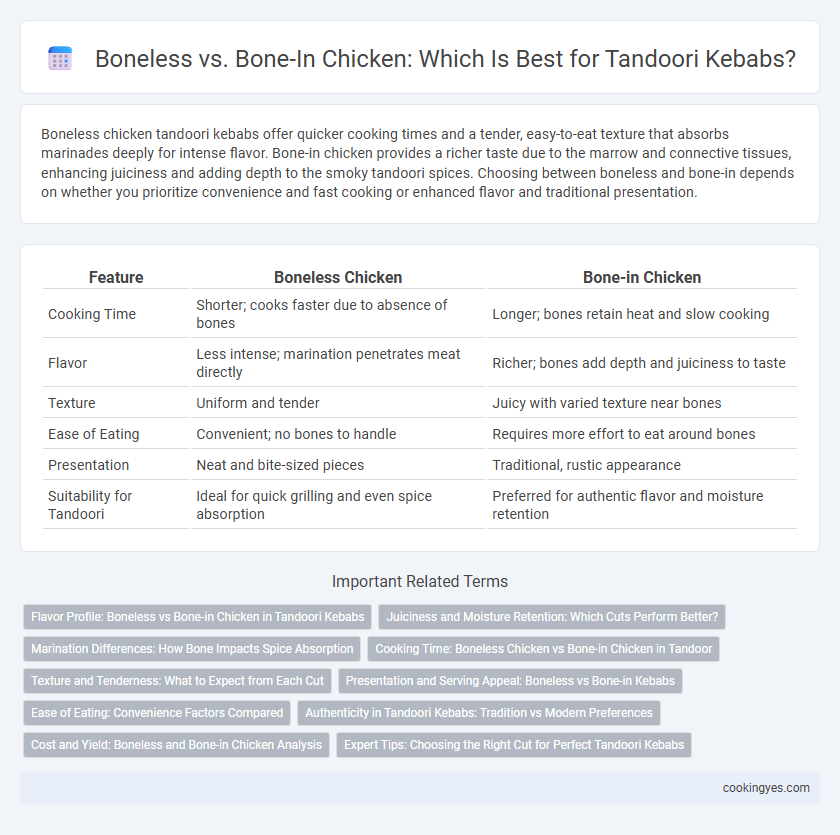Boneless chicken tandoori kebabs offer quicker cooking times and a tender, easy-to-eat texture that absorbs marinades deeply for intense flavor. Bone-in chicken provides a richer taste due to the marrow and connective tissues, enhancing juiciness and adding depth to the smoky tandoori spices. Choosing between boneless and bone-in depends on whether you prioritize convenience and fast cooking or enhanced flavor and traditional presentation.
Table of Comparison
| Feature | Boneless Chicken | Bone-in Chicken |
|---|---|---|
| Cooking Time | Shorter; cooks faster due to absence of bones | Longer; bones retain heat and slow cooking |
| Flavor | Less intense; marination penetrates meat directly | Richer; bones add depth and juiciness to taste |
| Texture | Uniform and tender | Juicy with varied texture near bones |
| Ease of Eating | Convenient; no bones to handle | Requires more effort to eat around bones |
| Presentation | Neat and bite-sized pieces | Traditional, rustic appearance |
| Suitability for Tandoori | Ideal for quick grilling and even spice absorption | Preferred for authentic flavor and moisture retention |
Flavor Profile: Boneless vs Bone-in Chicken in Tandoori Kebabs
Bone-in chicken in tandoori kebabs offers a richer, more robust flavor as the bones release marrow and natural juices during cooking, enhancing the overall taste experience. Boneless chicken provides a tender, easily marinated texture that absorbs spices more uniformly, resulting in a consistent and intense flavor throughout. The choice between bone-in and boneless impacts both the juiciness and depth of flavor, with bone-in favored for traditional, smoky richness and boneless preferred for quick, evenly spiced kebabs.
Juiciness and Moisture Retention: Which Cuts Perform Better?
Boneless chicken tends to absorb marinades more thoroughly, enhancing flavor but sometimes sacrificing juiciness during cooking. Bone-in chicken retains moisture better because the bone acts as a heat buffer, preventing the meat from drying out and resulting in a more succulent tandoori kebab. Studies of meat cooking dynamics consistently show bone-in cuts outperform boneless in moisture retention and overall tenderness.
Marination Differences: How Bone Impacts Spice Absorption
Bone-in chicken tandoori kebabs absorb marinades differently due to heat retention around the bone, which allows spices to penetrate more deeply and evenly into the meat. Boneless chicken offers faster marination as the absence of bone permits quicker spice infusion but may result in less intense flavor development. The bone's thermal conductivity enhances the cooking process, creating juicier, more flavorful kebabs with a balanced spice profile.
Cooking Time: Boneless Chicken vs Bone-in Chicken in Tandoor
Boneless chicken cooks significantly faster in a tandoor, typically requiring 12-15 minutes due to its uniform thickness and absence of bone, promoting even heat distribution. Bone-in chicken, however, demands longer cooking time, around 25-30 minutes, as the bone slows heat penetration, ensuring juicy meat but requiring careful temperature control. Choosing boneless chicken benefits quicker meal preparation, while bone-in offers enhanced flavor from marrow but needs patience for thorough cooking.
Texture and Tenderness: What to Expect from Each Cut
Boneless chicken tandoori kebabs offer a consistently tender and juicy texture due to direct marinade absorption and even cooking, making them ideal for quick grilling. Bone-in chicken provides enhanced flavor complexity and moisture retention, resulting in a richer, more succulent bite but with slightly firmer meat around the bones. Choosing between boneless and bone-in cuts affects the kebab's tenderness, with boneless favoring soft, easy-to-eat pieces and bone-in delivering a more robust, traditional texture.
Presentation and Serving Appeal: Boneless vs Bone-in Kebabs
Boneless chicken tandoori kebabs offer a cleaner, more uniform presentation, making them ideal for formal settings or appetizer platters where ease of eating is prioritized. Bone-in chicken kebabs, with their rustic appeal and richer flavor infusion, present a visually striking dish that highlights traditional cooking methods and enhances the dining experience. The choice between boneless and bone-in significantly influences serving style, with boneless suited for quick servings and bone-in favoring a more leisurely, shareable meal presentation.
Ease of Eating: Convenience Factors Compared
Boneless chicken tandoori kebabs offer superior ease of eating due to their tender, bite-sized pieces that require no additional effort to separate from the bone, making them a convenient choice for on-the-go dining and casual settings. Bone-in chicken tandoori maintains richer flavor profiles and juiciness but demands more time and attention to navigate around bones, which can slow down consumption and reduce portability. For consumers prioritizing convenience and mess-free experience, boneless options enhance accessibility without sacrificing tradition.
Authenticity in Tandoori Kebabs: Tradition vs Modern Preferences
Bone-in chicken is traditionally favored in authentic tandoori kebabs for its ability to retain moisture and impart deeper, richer flavors through slow cooking in the tandoor. Boneless chicken caters to modern preferences by offering convenience and quicker cooking times but may sacrifice the nuanced taste achieved by marrow and bone interaction. The choice between bone-in and boneless ultimately influences the texture, juiciness, and authenticity of traditional tandoori kebabs.
Cost and Yield: Boneless and Bone-in Chicken Analysis
Boneless chicken for tandoori kebabs generally incurs higher costs due to additional processing but offers a higher yield percentage with easier portion control and less waste. Bone-in chicken is more economical per pound with greater flavor retention during cooking, though it yields less edible meat and requires more handling time. Choosing between boneless and bone-in chicken depends on balancing cost efficiency with preparation preferences and flavor intensity.
Expert Tips: Choosing the Right Cut for Perfect Tandoori Kebabs
Boneless chicken offers even marination penetration and faster cooking times, ideal for tender, quick-cooked tandoori kebabs, while bone-in chicken provides richer flavor and juicier texture due to marrow infusion during grilling. Experts recommend selecting bone-in cuts like leg quarters or thighs for authentic, robust taste, whereas boneless breast pieces are preferable for uniform kebab grilling and convenient handling. Balancing marinade absorption and cooking consistency ensures perfectly charred, flavorful tandoori kebabs suited to both casual and gourmet preparation.
Boneless chicken vs Bone-in chicken for tandoori kebabs Infographic

 cookingyes.com
cookingyes.com